On the way to work...
Not much news to report. I went to a bbq and a house party on Friday, and over to the Intercontinental hotel for dinner with some journalists last night. With extreme gratitude for their hospitality and generosity, I am staying with Fred and Mary now, who are very, very nice even though I fear they are not... how do I say this... I fear they aren't huggers, or at least I never feel like I should hug them. Maybe when we know each other better... They have an 80 pound puppy -- 8 months old sheep dog, and two kittens, and two birds, so my love for animals is well gratified. I still have a terrible cough -- maybe it's pertussis! Not really. I can hardly joke about things like that, I know. Really I think it is because I came with a cough and put that together with the altitude (we are at about 6000 feet), the really really dry weather, and the desert dust that blankets the city in the mornings and afternoons, and that makes for a pretty uncomfortable cough. Ah, well.
I thought it might be interesting to list some of the things that I pass on the way to work in the mornings. I tried to take note of all of the different things, but there are so many, it is impossible to note them all! First, around 7:30am, there's a rapid succession of three beeps and the guard comes over to where we are sitting on the patio and tells us that "motor" has come. We climb in, usually in a van, but sometimes an SUV. I like to sit by a window so that I can absorb the sights. On the street that I live on (my address is House 22, on the second street, in Fatala, Kabul), there are a lot of tailors. These are tiny shops, jam packed with three or four workers, two or three old singer sewing machines, and an old bench or two. Along the way, we pass lots of other types of little shops. Tiny little establishments all over the place -- the Afghans have always been industrious and entrepreneurial. There are shops selling everything. Usually a lot of fruit (there must be a million watermelons here) and vegetables in wooden crates piled in front of some tiny little establishment that we would identify anywhere else as a shack. Often you will see a palot with a dirty, torn old blanket, and you know that this is also the owner's home. Other items for sale in these sell-alls are metal kitchenware (very elaborate pitchers and pots), bottles of water, fanta, coke, and who knows what other knick-knacks are available. Here there is a shop with the morning’s fresh-baked naan hanging like drapes from the fronts of the shop, tempting passers by. There are a few designated areas along the way, where the shops on one street are all selling the same thing. First we pass the motorbike and bicycle shops. Later on, around the corner, past the next few blocks, there are the stationery shops. We pass some more demolished, bullet-hole-riddled, barely standing buildings. We almost hit that old man on a bicycle, his turban a bit dissheveled, his vest a bit tattered (why do all these Aghan men wear vests over their shalwar kameez? a king in the 1920s was very into westernizing Afghanistan, and tried to make everyone dress western. of course, they refused. the new ordinance then was to wear the vest over the traditional dress. it still lasts today!). We stall in traffic, three cars in "our" lane, one turning right, two turning left, we trying to go straight. We are all stuck, honking at each other, inching our way to gain the right-of-way.

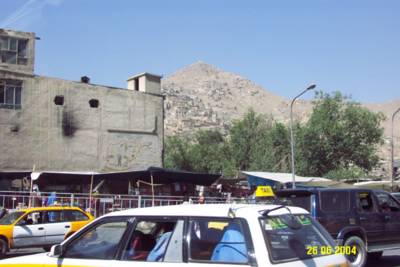
Pedestrians and cyclists take advantage of this and weave in and out between the vehicles. Most of these vehicles are taxis -- school bus yellow with four white doors. Every now and again we pass a white SUV with a huge blue UN painted on the side. Some of the traffic are donkeys hooked up by wooden poles to wooden carts. Some of these have a third pole in front tied at either end to the other two, and a man in the center pushing pushing against his load, often larger than the load the horses or donkeys are pulling. Men walk by holding hands. Women walk by holding children. Little barefoot boys press their faces against our windows, and tap tap tap to gain our attention. Some of them try to sell old tattered books (photocopies), some try to sell newspapers. This morning, one little boy was selling an old tin can with a bunch of smoke coming out of it. One of our Pashtu colleagues explained to us that it is the seeds of a fruit whose smoke is known to protect you from evil if you pass through it. Other children aren't selling anything but their clearly destitute existence. They aren't all children either. This morning, a woman in a very old, make-shift burqa knocked on the window and then an old toothless man with a white beard and a dirty turban pushed her out of the way to gain his chance at convincing the wealthy passengers to donate to their plight. We aren't allowed to roll down our windows. I am ashamed to turn my head and pretend not to notice. We are moving again. I am relieved momentarily of my guilts. Around the traffic "cop" in the center, past the soldiers with their rifles over their soldiers.

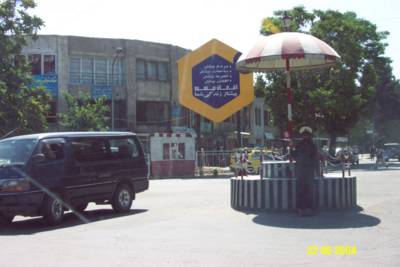
The next street is all of the photo shops. At the next intersection, there are two large buildings, five stories high, all bombed out. There is no front wall, you just look straight into the remaining shells of the rooms. Some parts of the floors/ceilings are caving in, some pieces are still miraculously dangling by their metal tendons. Buildings here are made of mud bricks, and covered over with a layer of concrete. The foundations and supports are usually wooden poles for homes. Some of the metal ones were built during the Soviet occupation. Anyway, in this one building at this intersection, I noticed this morning a tarp spread out over one of the open-air rooms and tables and chairs underneath. Someone has turned it into a restaurant! (note the red and white tarp on the right side of the photo, and the rest of the crumbly building to the left)


Turning west now, we inch through the traffic to the next intersection. This is where you will find all sorts of clothes for sale, pants, vests, dresses, shoes, T shirts, chadri… all hanging from the metal fences that line the street.

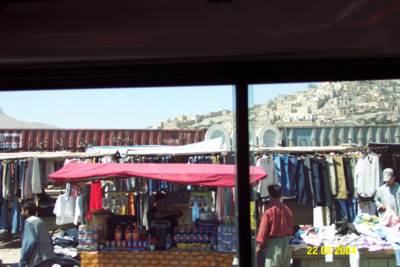
Here also (but coming from the other direction) is the woman in a light blue burqa, barefoot, holding a small barefoot child, standing in the middle of the street. Sometimes she sits in her same spot… I wonder if she trusts that the cars will not hit her, or if she believes that if they do, she is better off anyway… I think a lot about her, and about the millions of people around the world who are hungry, whose every day is about trying to gather enough money for food. I am amazed by their strength and ashamed of my own weaknesses in times that seem so difficult and desperate to my privileged mind.
We turn right, pass the butchers, with headless, skinned pigs and goats hanging from their feet.

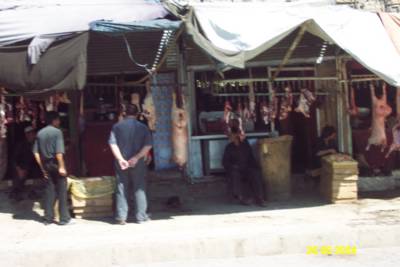
Just beyond this is my favorite, the spice sellers! Giant sacks and metal bowls full of so many different brightly colored powders -- it really does look like an artist's palette! I long to get out of the car and wander among them, to breathe in the exotic confluence of smells, and to take photos to share with you all. Maybe before I go…
Another left at the monument (what is it?) beneath which there are always armed guards. I always wonder if they sleep on the twin beds that are there, or if they just use them to have tea in the afternoons. Now through the Lion’s Gate – the part of Kabul where the three mountains converge – and another left. There is the man with an amputated leg, seated in the same spot as he was yesterday and the day before and the day before. This is the road that takes us through the most destroyed part of the city, that which was hardest hit during the civil war, and where our office compound is (along with Save the Children, and a Red Cross outpost).


This used to be the most developed and beautiful part of the city until the Taliban times. Now it is a skeleton of its formerly vibrant self. We pass more fruit shops – these are about the size of a single car garage, and look basically like that. They are hollow mud squares, with a corrugated tin door that opens to the public when the business day begins.

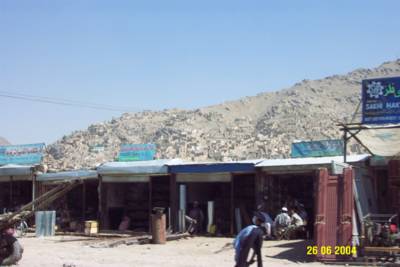
On the left, there are several construction-oriented shops—selling bricks, cement, stones, bamboo poles, other wooden poles, and some machinery.


I am always tickled by the sight of the work trucks – 6 wheelers up to 18 wheelers – from Pakistan usually, that are painted with great detail, tiny patterns and designs in a whole range of really bright colors. Reds and yellows and bright blues and greens. And often there are little chains with bells and other noise-makers dangling from the front and the back.
Farther along, we are almost to our office, we pass the construction site of what is rumored to be a new “Islam University.” The remnants of previous buildings still remain, with dramatic archways standing alone, no great halls left to lead people into. This is sort of like the ancient city of Rome, where with enough imagination, you can almost see the glory of the buildings that once stood. Except that beyond the archways is a lot of crumpled, rusting, metal frames of vehicles that were casualties (probably along with their drivers and passengers) of the war.





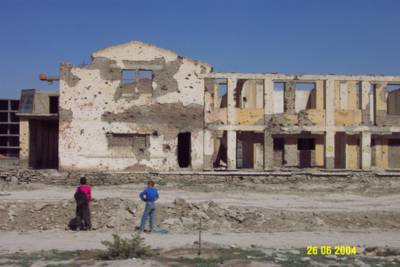
Just before we arrive at our compound, the last image we see is one of hope – tens of little girls, in black with white headscarves, carrying black backpacks (I saw a Mickey Mouse on one this morning), heading to school. Many of them are already more educated than their mothers, who are part of that generation of women who were not allowed to go to school and who still feel more comfortable looking at the world from behind the screen of a burqa. But these girls will be different, and I am glad for them.
Just beyond the school, we turn left onto the bumpy dirt road that will take us to the back entrance of our compound. Sometimes we have to wait a few seconds while a little boy shepherds his goats out of the way.



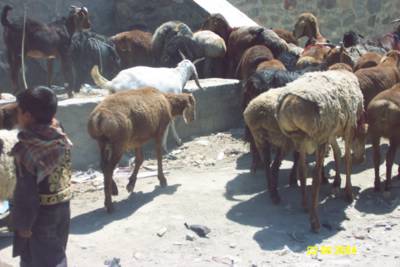
Usually there are one or two little boys who stare at the van and proudly practice their, “Hello!” and wave. I wave back, and they turn to look at each other with delight, laughing.
Inside our compound, the grass is thick and green, and grape vines grow overhead along the walkways. Beyond the high cement walls, the mountains of Kabul look to me like they are digitalized – they stand out with sharp margins against the sky. Little mud Afghan houses decorate the sides of the mountain, up up near the tops, and I wonder about the child or woman who has to carry water up from the wells below.
For the rest of the day, I am largely insulated from the post-conflict, third world country that I am in. I work to try to get my project going. Things move a bit slowly here. But I am so glad to be here, so glad to be surrounded by people – Afghans and expats alike – all working to rebuild the country. At least once a day, it really hits me – I am in Afghanistan.
I hope this gives you a sense of what it is like here. I can't really find the right words for most of what I want to say, so I am glad that I am able to share a few photos. More again soon...
I thought it might be interesting to list some of the things that I pass on the way to work in the mornings. I tried to take note of all of the different things, but there are so many, it is impossible to note them all! First, around 7:30am, there's a rapid succession of three beeps and the guard comes over to where we are sitting on the patio and tells us that "motor" has come. We climb in, usually in a van, but sometimes an SUV. I like to sit by a window so that I can absorb the sights. On the street that I live on (my address is House 22, on the second street, in Fatala, Kabul), there are a lot of tailors. These are tiny shops, jam packed with three or four workers, two or three old singer sewing machines, and an old bench or two. Along the way, we pass lots of other types of little shops. Tiny little establishments all over the place -- the Afghans have always been industrious and entrepreneurial. There are shops selling everything. Usually a lot of fruit (there must be a million watermelons here) and vegetables in wooden crates piled in front of some tiny little establishment that we would identify anywhere else as a shack. Often you will see a palot with a dirty, torn old blanket, and you know that this is also the owner's home. Other items for sale in these sell-alls are metal kitchenware (very elaborate pitchers and pots), bottles of water, fanta, coke, and who knows what other knick-knacks are available. Here there is a shop with the morning’s fresh-baked naan hanging like drapes from the fronts of the shop, tempting passers by. There are a few designated areas along the way, where the shops on one street are all selling the same thing. First we pass the motorbike and bicycle shops. Later on, around the corner, past the next few blocks, there are the stationery shops. We pass some more demolished, bullet-hole-riddled, barely standing buildings. We almost hit that old man on a bicycle, his turban a bit dissheveled, his vest a bit tattered (why do all these Aghan men wear vests over their shalwar kameez? a king in the 1920s was very into westernizing Afghanistan, and tried to make everyone dress western. of course, they refused. the new ordinance then was to wear the vest over the traditional dress. it still lasts today!). We stall in traffic, three cars in "our" lane, one turning right, two turning left, we trying to go straight. We are all stuck, honking at each other, inching our way to gain the right-of-way.


Pedestrians and cyclists take advantage of this and weave in and out between the vehicles. Most of these vehicles are taxis -- school bus yellow with four white doors. Every now and again we pass a white SUV with a huge blue UN painted on the side. Some of the traffic are donkeys hooked up by wooden poles to wooden carts. Some of these have a third pole in front tied at either end to the other two, and a man in the center pushing pushing against his load, often larger than the load the horses or donkeys are pulling. Men walk by holding hands. Women walk by holding children. Little barefoot boys press their faces against our windows, and tap tap tap to gain our attention. Some of them try to sell old tattered books (photocopies), some try to sell newspapers. This morning, one little boy was selling an old tin can with a bunch of smoke coming out of it. One of our Pashtu colleagues explained to us that it is the seeds of a fruit whose smoke is known to protect you from evil if you pass through it. Other children aren't selling anything but their clearly destitute existence. They aren't all children either. This morning, a woman in a very old, make-shift burqa knocked on the window and then an old toothless man with a white beard and a dirty turban pushed her out of the way to gain his chance at convincing the wealthy passengers to donate to their plight. We aren't allowed to roll down our windows. I am ashamed to turn my head and pretend not to notice. We are moving again. I am relieved momentarily of my guilts. Around the traffic "cop" in the center, past the soldiers with their rifles over their soldiers.


The next street is all of the photo shops. At the next intersection, there are two large buildings, five stories high, all bombed out. There is no front wall, you just look straight into the remaining shells of the rooms. Some parts of the floors/ceilings are caving in, some pieces are still miraculously dangling by their metal tendons. Buildings here are made of mud bricks, and covered over with a layer of concrete. The foundations and supports are usually wooden poles for homes. Some of the metal ones were built during the Soviet occupation. Anyway, in this one building at this intersection, I noticed this morning a tarp spread out over one of the open-air rooms and tables and chairs underneath. Someone has turned it into a restaurant! (note the red and white tarp on the right side of the photo, and the rest of the crumbly building to the left)


Turning west now, we inch through the traffic to the next intersection. This is where you will find all sorts of clothes for sale, pants, vests, dresses, shoes, T shirts, chadri… all hanging from the metal fences that line the street.


Here also (but coming from the other direction) is the woman in a light blue burqa, barefoot, holding a small barefoot child, standing in the middle of the street. Sometimes she sits in her same spot… I wonder if she trusts that the cars will not hit her, or if she believes that if they do, she is better off anyway… I think a lot about her, and about the millions of people around the world who are hungry, whose every day is about trying to gather enough money for food. I am amazed by their strength and ashamed of my own weaknesses in times that seem so difficult and desperate to my privileged mind.
We turn right, pass the butchers, with headless, skinned pigs and goats hanging from their feet.


Just beyond this is my favorite, the spice sellers! Giant sacks and metal bowls full of so many different brightly colored powders -- it really does look like an artist's palette! I long to get out of the car and wander among them, to breathe in the exotic confluence of smells, and to take photos to share with you all. Maybe before I go…
Another left at the monument (what is it?) beneath which there are always armed guards. I always wonder if they sleep on the twin beds that are there, or if they just use them to have tea in the afternoons. Now through the Lion’s Gate – the part of Kabul where the three mountains converge – and another left. There is the man with an amputated leg, seated in the same spot as he was yesterday and the day before and the day before. This is the road that takes us through the most destroyed part of the city, that which was hardest hit during the civil war, and where our office compound is (along with Save the Children, and a Red Cross outpost).


This used to be the most developed and beautiful part of the city until the Taliban times. Now it is a skeleton of its formerly vibrant self. We pass more fruit shops – these are about the size of a single car garage, and look basically like that. They are hollow mud squares, with a corrugated tin door that opens to the public when the business day begins.


On the left, there are several construction-oriented shops—selling bricks, cement, stones, bamboo poles, other wooden poles, and some machinery.


I am always tickled by the sight of the work trucks – 6 wheelers up to 18 wheelers – from Pakistan usually, that are painted with great detail, tiny patterns and designs in a whole range of really bright colors. Reds and yellows and bright blues and greens. And often there are little chains with bells and other noise-makers dangling from the front and the back.
Farther along, we are almost to our office, we pass the construction site of what is rumored to be a new “Islam University.” The remnants of previous buildings still remain, with dramatic archways standing alone, no great halls left to lead people into. This is sort of like the ancient city of Rome, where with enough imagination, you can almost see the glory of the buildings that once stood. Except that beyond the archways is a lot of crumpled, rusting, metal frames of vehicles that were casualties (probably along with their drivers and passengers) of the war.






Just before we arrive at our compound, the last image we see is one of hope – tens of little girls, in black with white headscarves, carrying black backpacks (I saw a Mickey Mouse on one this morning), heading to school. Many of them are already more educated than their mothers, who are part of that generation of women who were not allowed to go to school and who still feel more comfortable looking at the world from behind the screen of a burqa. But these girls will be different, and I am glad for them.
Just beyond the school, we turn left onto the bumpy dirt road that will take us to the back entrance of our compound. Sometimes we have to wait a few seconds while a little boy shepherds his goats out of the way.




Usually there are one or two little boys who stare at the van and proudly practice their, “Hello!” and wave. I wave back, and they turn to look at each other with delight, laughing.
Inside our compound, the grass is thick and green, and grape vines grow overhead along the walkways. Beyond the high cement walls, the mountains of Kabul look to me like they are digitalized – they stand out with sharp margins against the sky. Little mud Afghan houses decorate the sides of the mountain, up up near the tops, and I wonder about the child or woman who has to carry water up from the wells below.
For the rest of the day, I am largely insulated from the post-conflict, third world country that I am in. I work to try to get my project going. Things move a bit slowly here. But I am so glad to be here, so glad to be surrounded by people – Afghans and expats alike – all working to rebuild the country. At least once a day, it really hits me – I am in Afghanistan.
I hope this gives you a sense of what it is like here. I can't really find the right words for most of what I want to say, so I am glad that I am able to share a few photos. More again soon...



4 Comments:
ninest123 08.15
kate spade outlet, ray ban sunglasses, true religion jeans, polo ralph lauren outlet, nike air max, nike air max, michael kors, nike free, coach factory outlet, michael kors outlet, gucci outlet, michael kors outlet, tiffany jewelry, michael kors outlet, longchamp outlet, replica watches, michael kors outlet, louboutin shoes, christian louboutin outlet, longchamp outlet, true religion jeans, coach purses, prada outlet, true religion jeans, polo ralph lauren outlet, oakley sunglasses, burberry, oakley sunglasses, burberry outlet online, ray ban sunglasses, louboutin outlet, nike outlet, tory burch outlet, longchamp, coach outlet, coach outlet, jordan shoes, michael kors outlet, chanel handbags, oakley sunglasses, prada handbags, louboutin, tiffany and co, kate spade handbags
nike air max, herve leger, asics running shoes, new balance, instyler, north face outlet, wedding dresses, baseball bats, ralph lauren, lululemon, jimmy choo shoes, beats by dre, nfl jerseys, ghd, north face outlet, babyliss, hollister, insanity workout, hollister, chi flat iron, louboutin, valentino shoes, celine handbags, vans shoes, oakley, ferragamo shoes, soccer shoes, iphone 6 cases, giuseppe zanotti, vans, timberland boots, abercrombie and fitch, mac cosmetics, nike roshe, hollister, nike air max, bottega veneta, converse, reebok shoes, p90x workout, birkin bag, mcm handbags, mont blanc, soccer jerseys
20151106 junda
nike air jordan
soccer jerseys
mont blanc pens
sac longchamp
cheap ugg boots
michael kors outlet
michael kors
ugg outlet
adidas gazelle
coach outlet
michael kors outlet
michael kors
ugg sale
nike uk
ray ban
air jordan pas cher
louis vuitton handbags
longchamp bags
nike trainers
juicy couture
moncler jackets
michael kors bags
cheap ugg boots
coach factory outlet
louis vuitton handbags
michael kors uk
louis vuitton
ghd hair straighteners
true religion outlet
michael kors outlet uk
moncler jackets
canada goose uk
cheap uggs
louboutin pas cher
coach outlet
toms wedges
running shoes
new balance outlet
kate spade handbags
cheap jordan shoes
تنظيف بالبخار فى راس الخيمة
شركة نظافة فى راس الخيمة
Post a Comment
<< Home